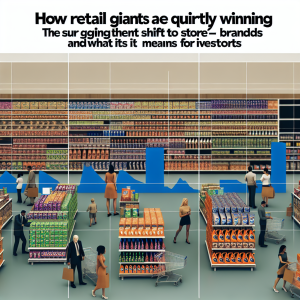In the evolving landscape of consumer retail, a quiet revolution is reshaping how shoppers choose products—and it’s not just about price anymore. Private-label products, once the bargain-basement alternative to name brands, have surged in popularity to a record $271 billion in U.S. sales last year, according to the Private Label Manufacturers Association. But what’s driving this shift goes beyond the inflation squeeze; it’s a sophisticated blend of savvy marketing, packaging innovation, and changing consumer perceptions that’s blurring the lines between store brands and their national counterparts.
The New Face of Private Labels: More Than Just a Discount
Historically, private-label goods were easily identifiable by their no-frills packaging—think plain bags or boxes signaling “we’re saving you money.” Today, that narrative has flipped. Retailers are investing heavily in packaging design, elevating store brands to a level that rivals, and sometimes surpasses, name-brand aesthetics. Bruce Myers, a packaging design expert at Rochester Institute of Technology, highlights how improved printing quality and design sophistication are helping private labels shed their budget-image stigma. This isn’t just cosmetic; it’s strategic.
A recent survey by First Insight revealed a striking insight: while 71% of consumers believe they can spot private-label items, 72% failed to correctly identify them when shown side-by-side with name-brand products. This suggests that consumers are unknowingly opting for store brands more often than they realize—a testament to how effectively retailers are positioning these products.
The Hidden Economics: Shared Manufacturing and Marketing Savings
Digging deeper, many private-label products are manufactured by the same companies that produce name brands. The difference? Name brands invest heavily in marketing, shelf placement fees, and brand-building campaigns. Private labels sidestep much of these costs, allowing them to offer competitive pricing without compromising quality. This structural advantage is reshaping the competitive dynamics in grocery aisles.
Consider the recent legal clash where Mondelēz International sued Aldi, accusing the retailer of copying the packaging of iconic snacks like Oreos and Ritz crackers. This lawsuit underscores how fiercely name brands guard their market share, but also highlights how private labels are pushing boundaries to capture consumer attention.
What This Means for Investors and Advisors
For investors, the rise of private labels signals a shift in consumer behavior that will impact retail and consumer packaged goods (CPG) stocks. Companies like General Mills and Procter & Gamble, which have traditionally relied on brand loyalty to maintain pricing power, are now pivoting to emphasize value and volume growth. General Mills recently announced a strategic shift to invest more in consumer value after a series of price hikes.
From an investment perspective, this could mean increased volatility for traditional CPG stocks as they navigate changing consumer preferences and pricing pressures. Conversely, retailers with strong private-label offerings—like Costco and Aldi—may continue to gain market share and deliver steady growth. This trend also opens opportunities for investors in packaging design and marketing technology firms that enable this premium private-label experience.
Actionable Insights: What Should Advisors and Investors Do Now?
-
Reassess Consumer Staples Holdings: Investors should critically evaluate the pricing strategy and innovation pipeline of major CPG companies. Those that adapt by enhancing value propositions and embracing private-label competition may outperform.
-
Monitor Retailers with Strong Private-Label Programs: Retailers like Costco and Aldi are well-positioned to capitalize on this trend. Their ability to offer high-quality private-label products at lower prices can drive customer loyalty and margin expansion.
-
Explore Packaging and Branding Innovators: Companies specializing in packaging technology and design services that cater to private labels represent a niche growth area worth watching.
-
Stay Alert to Legal and Regulatory Developments: The Mondelēz vs. Aldi lawsuit highlights risks around intellectual property that can affect private-label growth trajectories.
Looking Ahead: The Future of Brand Loyalty and Pricing Power
Despite the headwinds, experts like Wells Fargo’s Michael Swanson don’t foresee private labels displacing name brands entirely. Instead, name brands will continue setting price benchmarks, with private labels positioned as the value alternative. Interestingly, grocery prices have risen over 23% in five years, but adjusted for inflation and wage growth, groceries are actually more affordable than in decades. For example, 2024’s Thanksgiving dinner was the most affordable in nearly 40 years, according to USDA data.
This paradox underscores a critical investor takeaway: consumer psychology and perceived value often outweigh raw price changes. As shoppers become more value-conscious yet less brand-loyal, companies that can balance quality, price, and brand experience will win.
Final Thought: Private Labels Are Not Just a Trend, They’re a Structural Shift
The rise of private labels is more than a fleeting response to inflation—it’s a structural shift in retail economics and consumer behavior. For investors and advisors, the key is to recognize that the competitive moat for traditional brands is narrowing. The winners will be those who innovate in product quality, consumer engagement, and pricing strategy while navigating a marketplace where the “name on the box” matters less than ever.
By staying ahead of these dynamics, you can position portfolios to benefit from the evolving grocery wars—where value, perception, and smart branding define the new battleground.
Sources:
- Private Label Manufacturers Association, January 2024 Report
- First Insight Consumer Survey, 2024
- Wells Fargo Agri-Food Institute, Michael Swanson Interview, 2024
- USDA Economic Research Service, 2024 Thanksgiving Cost Analysis
Source: Shoppers are trading down to store brands without even realizing it

